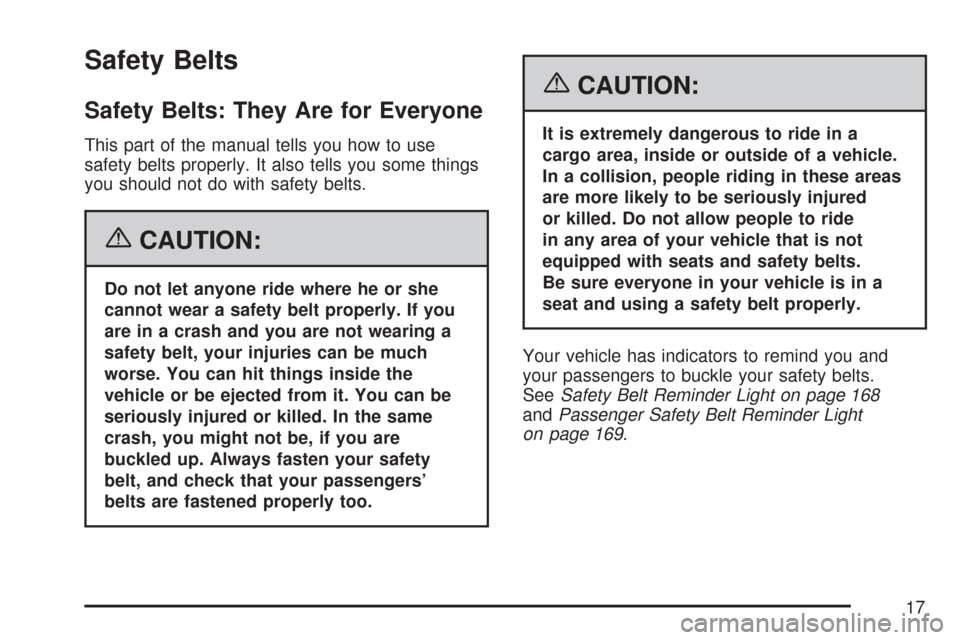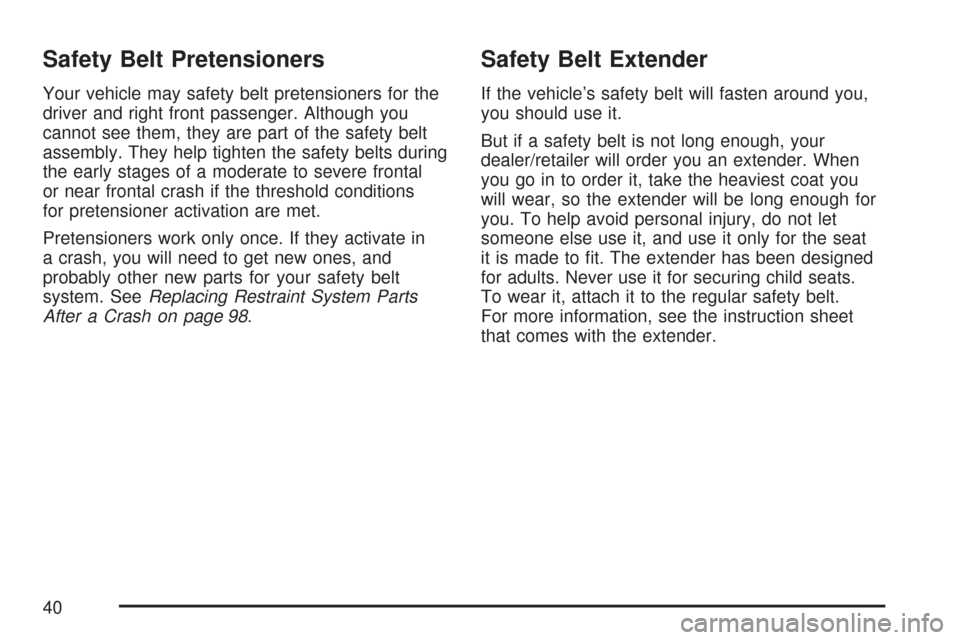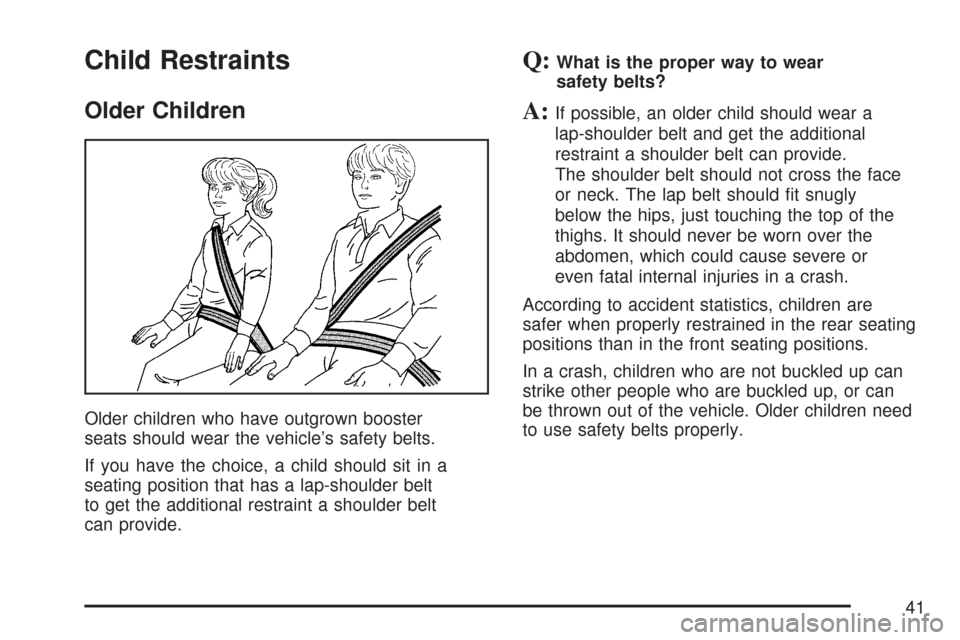Page 14 of 458
2. Locate the pins. There are two pins located
on the inboard sides of the rear seats. If the
vehicle has floor mats, the pins will be located
under a flap that has been cut into the mat.
•The driver’s side pin has a gray cap with
a black “L” marked on it.
•The passenger’s side pin has a black cap
with a white “R” marked on it.
3. Pull the pin handle up to disengage the pin
from the retaining clip, then pull the pin out.
4. Repeat this procedure for the pin on the
other seat base.
5. Pull the seat rearward about 2 inches (5 cm)
and then lift the seat from the floor rails.
6. Remove the seat from the vehicle.
14
Page 15 of 458

7. For the first row
rear seat, stow the
safety belt latch
by attaching the clip
on the safety belt
latch to the trim
just inside the
side door.
For the remaining rear seats, stow the safety
belt latch plate on the clip at the window trim.
Replacing the Rear Seats
{CAUTION:
A seat that is not locked into place
properly can move around in a collision
or sudden stop. People in the vehicle
could be injured. Be sure to lock the
seat into place properly when installing it.
{CAUTION:
A safety belt that is improperly routed,
not properly attached, or twisted will not
provide the protection needed in a crash.
The person wearing the belt could be
seriously injured. After raising the rear
seatback, always check to be sure that
the safety belts are properly routed and
attached, and are not twisted.
1. Position the seat into the open slots in
both rails. Push the seat forward in the
rail, hooking both seat bases onto the
pins inside of the rails.
2. To install the locking pins at the rear of the
seat base, locate the hole in the rail for the
pin. It is found on the inboard side of the seat.
If the vehicle has floor mats, pull the flap
that has been cut into the mat.
15
Page 17 of 458

Safety Belts
Safety Belts: They Are for Everyone
This part of the manual tells you how to use
safety belts properly. It also tells you some things
you should not do with safety belts.
{CAUTION:
Do not let anyone ride where he or she
cannot wear a safety belt properly. If you
are in a crash and you are not wearing a
safety belt, your injuries can be much
worse. You can hit things inside the
vehicle or be ejected from it. You can be
seriously injured or killed. In the same
crash, you might not be, if you are
buckled up. Always fasten your safety
belt, and check that your passengers’
belts are fastened properly too.
{CAUTION:
It is extremely dangerous to ride in a
cargo area, inside or outside of a vehicle.
In a collision, people riding in these areas
are more likely to be seriously injured
or killed. Do not allow people to ride
in any area of your vehicle that is not
equipped with seats and safety belts.
Be sure everyone in your vehicle is in a
seat and using a safety belt properly.
Your vehicle has indicators to remind you and
your passengers to buckle your safety belts.
SeeSafety Belt Reminder Light on page 168
andPassenger Safety Belt Reminder Light
on page 169.
17
Page 23 of 458

Driver Position
Lap-Shoulder Belt
The driver has a lap-shoulder belt. Here is how
to wear it properly.
1. Close and lock the door.
2. Adjust the seat so you can sit up straight.
To see how, see “Seats” in the Index.
3. Pick up the latch plate and pull the belt across
you. Do not let it get twisted.The lap-shoulder belt may lock if you pull the
belt across you very quickly. If this happens,
let the belt go back slightly to unlock it.
Then pull the belt across you more slowly.
4. Push the latch plate into the buckle until it clicks.
Pull up on the latch plate to make sure it is
secure. If the belt is not long enough,
seeSafety Belt Extender on page 40.
Make sure the release button on the buckle is
positioned so you would be able to unbuckle
the safety belt quickly if you ever had to.
5. Move the shoulder belt height adjuster to the
height that is right for you. Improper shoulder
belt height adjustment could reduce the
effectiveness of the safety belt in a crash. See
Shoulder Belt Height Adjustment on page 31.
23
Page 33 of 458
Center Passenger Position
(3rd, 4th and 5th Row)
Lap Belt
If your vehicle has third, fourth or fifth row bench
seats, someone can sit in the center positions.
When you sit in a center seating position in the
third, fourth or fifth row, you have a lap safety belt,
which has no retractor. To make the belt longer,
tilt the latch plate and pull it along the belt.To make the belt shorter, pull its free end as
shown until the belt is snug.
Buckle, position and release it the same way
as the lap part of a lap-shoulder belt. If the belt
isn’t long enough, seeSafety Belt Extender
on page 40.
Make sure the release button on the buckle is
positioned so you would be able to unbuckle
the safety belt quickly if you ever had to.
33
Page 37 of 458
To unlatch the belt, push the button on the buckle.
For outboard seating positions, when the safety
belt is not in use, slide the latch plate up the safety
belt webbing. The latch plate should rest on the
stitching on the safety belt, near the guide loop
on the side wall.
Rear Safety Belt Comfort Guides
Rear shoulder belt comfort guides may provide
added safety belt comfort for older children
who have outgrown booster seats and for some
adults. When installed on a shoulder belt, the
comfort guide positions the belt away from
the neck and head.
There is one guide for each outside passenger
position in the rear seats. Here is how to install
a comfort guide to the safety belt:
1. Locate the guide in a pocket on the side of
the seatback.
37
Page 40 of 458

Safety Belt Pretensioners
Your vehicle may safety belt pretensioners for the
driver and right front passenger. Although you
cannot see them, they are part of the safety belt
assembly. They help tighten the safety belts during
the early stages of a moderate to severe frontal
or near frontal crash if the threshold conditions
for pretensioner activation are met.
Pretensioners work only once. If they activate in
a crash, you will need to get new ones, and
probably other new parts for your safety belt
system. SeeReplacing Restraint System Parts
After a Crash on page 98.
Safety Belt Extender
If the vehicle’s safety belt will fasten around you,
you should use it.
But if a safety belt is not long enough, your
dealer/retailer will order you an extender. When
you go in to order it, take the heaviest coat you
will wear, so the extender will be long enough for
you. To help avoid personal injury, do not let
someone else use it, and use it only for the seat
it is made to fit. The extender has been designed
for adults. Never use it for securing child seats.
To wear it, attach it to the regular safety belt.
For more information, see the instruction sheet
that comes with the extender.
40
Page 41 of 458

Child Restraints
Older Children
Older children who have outgrown booster
seats should wear the vehicle’s safety belts.
If you have the choice, a child should sit in a
seating position that has a lap-shoulder belt
to get the additional restraint a shoulder belt
can provide.
Q:What is the proper way to wear
safety belts?
A:If possible, an older child should wear a
lap-shoulder belt and get the additional
restraint a shoulder belt can provide.
The shoulder belt should not cross the face
or neck. The lap belt should fit snugly
below the hips, just touching the top of the
thighs. It should never be worn over the
abdomen, which could cause severe or
even fatal internal injuries in a crash.
According to accident statistics, children are
safer when properly restrained in the rear seating
positions than in the front seating positions.
In a crash, children who are not buckled up can
strike other people who are buckled up, or can
be thrown out of the vehicle. Older children need
to use safety belts properly.
41